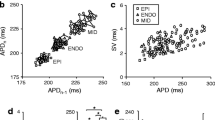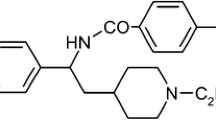Summary
The effects of altered extracellular K+ concentrations ([K+]0) and pacing cycle lengths (CLs) on the electrophysiological actions of dofetilide (UK-68,798), a potent class III antiarrhythmic agent, were examined in isolated guineapig ventricular papillary muscle. At a normal [K+]0 (4 mM) and at CL between 300 and 5000 msec, dofetilide (10 nM) significantly increased the action-potential duration (APD) and the effective refractory period (ERP), whereas other action-potential parameters were unaffected. Elevation of [K+]0 to 10 mM reduced membrane diastolic potential (MDP), action-potential amplitude (APA), and the maximum rising velocity of the action-potential upstroke (Vmax). These changes were accompanied by a small shortening of APD90, but with an increase in ERP; i.e., the ERP/APD90 ratio was increased. Dofetilide also significantly lengthened APD90 at 10 mM [K+]0 and at each CL. Even at the short cycle lengths (300 and 500 msec), dofetilide-induced increases in APD90 were not attenuated whether [K+]0 was at 4 or 10 mM. These results indicate that at various pacing CLs, 10 nM dofetilide increases myocardial APD and ERP to a similar extent without significant reverse use-dependence when the cell membrane is normally polarized or partially depolarized by elevated [K+]0. Dofetilide may, therefore, be expected to be beneficial in the treatment of cardiac tachyarrhythmias related or unrelated to regional myocardial hyperkalemia during myocardial ischemia.
Similar content being viewed by others
References
Cross PE, Arrowsmith JE, Thomas GN, et al. Selective class III antiarrhythmic agents. 1. Bis(arylalkyl)amines. J Med Chem 1990;33:1151–1155.
Tande PM, Bjørnstad H, Yang T, Refsum H. Rate-dependent class III antiarrhythmic action, negative chronotropy, and positive inotropy of a novel IK blocking drug, UK-68,798: Potent in guinea pig but no effect in rat myocardium. J Cardiovasc Pharmacol 1990;16:401–410.
Gwilt M, Arrowsmith JE, Blackburn KJ, et al. UK-68,798: A novel, potent and highly selective class III antiarrhythmic agent which blocks potassium channels in cardiac cells. J Pharmacol Exp Ther 1991;256:318–324.
Knilans T, Lathrop DA, Nánási PP, et al. Rate and concentration-dependent effects of UK-68,798, a potent new class III antiarrhythmic, on canine Purkinje fibre action potential duration and Vmax. Br J Pharmacol 1991;103: 1568–1572.
Carmeliet E. Effect on UK 68798 on delayed K+ currents in cardiac myocytes. Circulation 1991;84 (Suppl. II):II176.
Weiss J, Shine KI. Extracellular potassium accumulation during myocardial ischemia: Implication for arrhythmogenesis. J Mol Cell Cardiol 1981;13:699–704.
Cobbe SM, Manley BS. Effects of elevated extracellular potassium concentration on the class III antiarrhythmic action of sotalol. Cardiovasc Res 1985;19:69–75.
Duker G. On the use of monophasic action potential recording in experimental cardiac electrophysiology. Doctoral thesis, University of Gothenburg, Sweden, 1990, paper V.
Janse MJ, Wit AL. Electrophysiological mechanisms of ventricular arrhythmias resulting from myocardial ischemia and infarction. Physiol Rev 1989;69:1049–1169.
Hondeghem LM, Snyders DJ. Class III antiarrhythmic agents have a lot of potential but a long way to go: Reduced effectiveness and dangers of reverse used dependence. Circulation 1990;81:686–690.
Baskin EP, Serik CM, Wallace AA, et al. Effects of new and potent methanesulfonamide class III antiarrhythmic agents on myocardial refractoriness and contractility in isolated cardiac muscle. J Cardiovasc Pharmacol 1991;18: 406–414.
Anderson KP, Walker R, Dustman T, et al. Rate-related electrophysiologic effects of long-term administration of amiodarone on canine ventricular myocardium in vivo. Circulation 1989;79:948–958.
Colatsky TJ, Follmer CH, Starmer CF. Channel specificity in antiarrhythmic drug action: Mechanism of potassium channel block and its role in suppressing and aggravating cardiac arrhythmias. Circulation 1990;82:2235–2242.
Sedgewick M, Rasmussen HS, Cobbe SM. Pharmacokinetic and pharmacodynamic effects of UK-68,798, a new potential class III antiarrhythmic drug. Br J Clin Pharmacol 1991; 31:515–519.
Gemmill DJ, Howie CA, Meredith PA, et al. A dose-ranging study of UK-68,798, a novel class III antiarrhythmic agent, in normal volunteers. Br J Clin Pharmacol 1991;32:429–432.
Snedecor GW, Cochran WG, ed. Statistical methods. Ames, IA: Iowa State University Press, 1978.
Sanguinetti MC, Jurkiewicz NK. Two components of cardiac delayed rectifier K+ current: Differential sensitivity to block by class III antiarrhythmic agents. J Gen Physiol 1990; 96:195–215.
Harris DC, Bisrein A, Russell RA, et al. Excitatory factors in ventricular tachycardia resulting from myocardial ischemia: Potassium as a major excitant. Science 1954;119: 200–203.
Sheu SS, Korth M, Lathrop DA, Fozzard HA. Intra- and extracellular K+ and Na+ activities and resting membrane potential in sheep cardiac Purkinje strands. Circ Res 1980; 47:692–700.
Gettes LS, Reuter H. Slow recovery from inactivation of inward currents in mammalian myocardium fibers. J Physiol (Lond) 1974;240:703–724.
Noble D. Background currents and the effects of plasma ion concentration. In: Noble D, ed. The initiation of the heartbeat, 2nd ed. Oxford: Clarendon Press, 1979:119–131.
Singh BN, ed. Control of cardiac arrhythmias by lengthening repolarization. New York: Futura Publishing, 1988.
Cobbe SM. Modification of class III antiarrhythmic activity in abnormal myocardium. Cardiovasc Res 1988;22:847–854.
Cobbe SM, Manley BS, Alexopoulos D. The influence of acute myocardial ischaemia on the class III antiarrhythmic action of sotalol. Cardiovasc Res 1985;19:661–667.
Cobbe SM, Manley BS, Alexopoulos D. Interaction of the effects of hypoxia, substrate depletion, acidosis and hyperkalemia on the class III antiarrhythmic properties of sotalol. Cardiovasc Res 1985;19:668–673.
Steinberg MI, Sullivan ME, Wiest SA, et al. Cellular electrophysiology of clofilium, a new antifibrillatory agent, in normal and ischemic canine Purkinje fibers. J Cardiovasc Pharmacol 1981;3:881–895.
Hafner D, Berger F, Borchard U, et al. Electrophysiological characterization of the class III activity of sotalol and its enantisomers: New interpretation of use-dependent effects. Arzneim.-Forsch./Drug Res 1988;38:231–236.
Hill JL, Gettes LS. Effect of acute coronary artery occlusion on local myocardial extracellular K+ activity in swine. Circulation 1980;61:768–778.
Kleber AG. Extracellular potassium accumulation in acute myocardial ischemia. J Mol Cell Cardiol 1984;16:389–394.
Kass RS, Arena PJ, Walsh KB. Measurement and block of potassium channel currents in the heart: Importance of channel type. Drug Dev Res 1990;19:115–127.
McLarnon JG, Wang XP. Actions of cardiac drugs on a calcium-dependent potassium channel in hippocampal neurons. Mol Pharmacol 1991;39:540–546.
Wettwer E, Scholtysik G, Schaad A, et al. Effects of the new class III antiarrhythmic drug E-4031 on myocardial contractility and electrophysiological parameters. J Cardiovasc Pharmacol 1991;17:480–487.
Wallace AA, Stupienski RF, Brooks LM, et al. Cardiac electrophysiologic and inotropic actions of new and potent methanesulfonamide class III antiarrhythmic agents in anesthetized dogs. J Cardiovasc Pharmacol 1991;18:687–695.
Mortensen E, Yang T, Refsum H. Class III antiarrhythmic action and inotropy: Effects of dofetilide in acute ischemic heart failure in dogs. J Cardiovasc Pharmacol 1992;19: 216–221.
Gwilt M, Solca AM, Burges RA, et al. Antifibrillatory action and haemodynamic properties of UK-68,798, a new class III antiarrhythmic agent, in anaesthetized dogs. J Mol Cell Cardiol1989;21 (Suppl II):S11.
Black SC, Chi LG, Mu DX, Lucchesi RB. The antifibrillatory actions of UK-68,798, a class III antiarrhythmic agent. J Pharmacol Exp Ther 1991;258:416–423.
Maynard AE, Carpenter JF, Decker GE, Brooks RR. Efficacy of d-sotalol, sematilide and UK-68,798 in the rat coronary artery ligation-reperfusion (CALR) model of cardiac arrhythmias. FASEB J 1991;5:A1216.
Sedgewick ML, Rasmussen HS, Cobbe SM. Electrophysiological effects of UK-68,798, a new class III antiarrhythmic agent, in patients with ischemic heart disease. A doubleblind, placebo controlled study. Eur Heart J 1991;12 (Abstr. Suppl.):222.
Echt DS, Lee JT, Murray KT, et al. A randomized, doubleblind, placebo-controlled dose-ranging study of intravenous UK 68,798 (dofetilide) in patients with inducible sustained ventricular tachyarrhythmias. Circulation 1991;84 (Suppl II):II-714.
Author information
Authors and Affiliations
Rights and permissions
About this article
Cite this article
Yang, T., Tande, P.M., Lathrop, D.A. et al. Effects of altered extracellular potassium and pacing cycle length on the class III antiarrhythmic actions of dofetilide (UK-68,798) in guinea-pig papillary muscle. Cardiovasc Drug Ther 6, 429–436 (1992). https://doi.org/10.1007/BF00054193
Issue Date:
DOI: https://doi.org/10.1007/BF00054193




